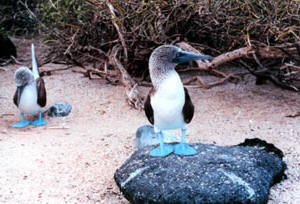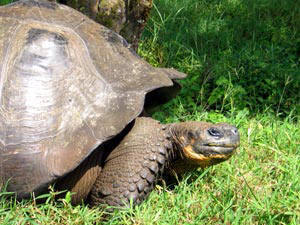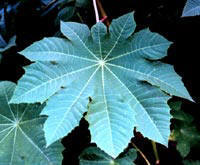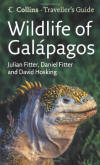| Tourism in the Galapagos
- What will I do and what will I see? |
|

|
The Galapagos Islands,
once known as the Islas Encantadas, offer much to the inquisitive
visitor. These islands, volcanic humps shoved above the
surface of the Pacific Ocean embrace one of the Earth's
premier natural history experiences.
Each day of a Galapagos cruise carries you
to new sites, rich and varied vegetation, tropical fish,
saltwater lakes, mangrove forests, red, black, and green
sand beaches, hardened lava flows from extinct volcanoes,
cormorants, herons, finches with distinct beaks, and penguins.
|
Natural History
Wildlife on the Galapagos makes you stop and wonder.
You breathe in the curiosity of biology. From cold-water penguins
to leaf-toed gecko lizards to the Galapagos sulphur butterflies,
this volcanic archipelago continues to amaze and puzzle its visitors.
According to the World Wildlife Fund, 75
percent of the land birds and 97 percent of the reptiles and mammals
on the Galapagos Islands are found nowhere else in the world.
Galapagos giant tortoises, which may live as long as 150 years and
weigh as much as 400 pounds, lumber so close to you that portrait
photography comes naturally. The islands isolation from the mainland
means that many birds, iguanas, tortoises, and other animals have
no natural predators. Their relative fearlessness of humans stems
from this geographic isolation. The Galapagos Islands played a crucial
role in the development of biological theories from evolution to
island biogeography.
 The
archipelago's largest denizens, the giant tortoises, are endemic
to almost all of the islands and, having outlived heavy harvesting
in the whaling era, are regarded as a symbol of survival in the
Galapagos. The Fernandina, Floreana, and Santa Fe tortoises are
extinct, leaving only 11 of the 14 original varieties. The
archipelago's largest denizens, the giant tortoises, are endemic
to almost all of the islands and, having outlived heavy harvesting
in the whaling era, are regarded as a symbol of survival in the
Galapagos. The Fernandina, Floreana, and Santa Fe tortoises are
extinct, leaving only 11 of the 14 original varieties.
The Galapagos' most famous tortoise, Lonesome George,
is the last known tortoise from the island of Pinta. Scientists
estimate that over 250,000 tortoises dominated these small islands
prior to the arrival of man. Today, 15,000 remain. The Charles Darwin
Research Station's 37-year captive breeding program, however, has
improved the species' outlook, releasing more than 2,600 tortoises
to 6 different islands, including 8 giant tortoise sub-species.
Marine iguanas, the world's only seagoing
lizards, fascinated Darwin. As a young man, he grabbed one by the
tail and swung it out into the ocean. It swam back. He repeated
the exercise until he deduced that on land, the iguana faced no
predators, but in the sea, unknown dangers lurked; though fully
equipped to swim, the iguana found safety on shore.
Wings fill the skies and shores of the archipelago.
Masked boobies and waved albatrosses ride the coastal thermals,
while flightless cormorants and penguins patrol the rocky shores.
Lava gulls squawk from above and Galapagos hawks scan for prey.
Galapagos land birds take a casual attitude toward humans, and although
they are not dramatic in color, their relative tameness makes them
delightful to observe.
Three species
of boobies are found in the Galapagos: the blue-footed, masked (white),
and red-footed booby. Blue-footed boobies are the most common
species of booby in the Galapagos Islands and are the favorite among
visitors, known for their astonishingly brightly colored sky-blue
feet. Their famous courtship ritual dance is characterized by raising
their feet one after the other, pointing their heads and bills in
the air, and spreading their crooked wings.
Boobies hunting technique involves dive-bombing
into the ocean from up to 80 feet in the air to feed on squid and
fish. Their tapered bills and pointed tail help to streamline their
bodies, while their air sacs in the skull and closing nostrils protect
them from any impact injuries.
Sally
Lightfoot crabs can be easily spotted throughout the islands quickly
scurrying about. This swiftness and ability to get out of
harm's way is what has given them their name: "Lightfoot." Unlike
most of the wildlife in the Galapagos, Sally Lightfoots are inclined
to run away as one tries to approach them and to view close up.
The young crabs are black and well camouflaged amongst the rocks.
The adults, however, are bright red and yellow, which dramatically
contrasts against the neutral-colored rocks and sand. When captured
by the camera, these crabs offer excellent composition for photographs!
Likely brought to the Galapagos by the
Humboldt Current coming from Antarctica, the Galapagos Penguin is
the smallest penguin, and the only one to live and breed
on the equator. Standing at approximately 14 inches in height, they
appear more duck-like than the penguins found in Antarctica. Adult
penguins have a bluish-black head, a white underside, and a thin
white band from their eye to their chin. In total, Galapagos Penguins
number just a couple of thousand. In fact, the breeding population
is estimated to be as low as 800 pairs. Visitors are most likely
to see them on Fernandina, Isabela, Santiago, Bartolome, northern
Santa Cruz and Floreana. Nesting occurs on Fernandina and Isabela.
 Undoubtedly
one of the favorite animals in the islands, the playful Galapagos
Sea Lions provide endless entertainment for visitors with
their amazing abilities in the water. Snorkeling and kayaking with
the pups is, not surprisingly, the highlight for many who visit
the Galapagos. Over time, Sea Lions have adapted to living more
in the water, as their ancestors were land animals who hunted along
the coastlines. This evolution, however, has not entirely adapted
them to water habitation; they can also be found on most beaches
napping, waddling or basking in the sun. Sea Lions live in large
colonies, and adult males, known as Bulls, are the head of the colony.
Bulls can grow to be up to 7 ft (2 m) in length and can weigh 800
lbs (363 kg). Undoubtedly
one of the favorite animals in the islands, the playful Galapagos
Sea Lions provide endless entertainment for visitors with
their amazing abilities in the water. Snorkeling and kayaking with
the pups is, not surprisingly, the highlight for many who visit
the Galapagos. Over time, Sea Lions have adapted to living more
in the water, as their ancestors were land animals who hunted along
the coastlines. This evolution, however, has not entirely adapted
them to water habitation; they can also be found on most beaches
napping, waddling or basking in the sun. Sea Lions live in large
colonies, and adult males, known as Bulls, are the head of the colony.
Bulls can grow to be up to 7 ft (2 m) in length and can weigh 800
lbs (363 kg).
The Galapagos Fur Seals, far more timid than
the Sea Lion, shelter themselves from the sun in shelves or caves
of lava cliffs during the day. During the 18th century, these animals
were heavily hunted, nearly to extinction. Today, however, their
population is more comparable to that of Sea Lions.
Whether
you choose to watch the sea lions and fur seals in the ocean or
the marine iguanas on the rocks, the Galapagos offers an odd assemblage
of species that brings out the biologist in all of us.
Dress is casual and comfortable,
and informality is basic to all activities. We recommend
you pack using a soft-side suitcase. Please remember that
the checked luggage you take aboard your TAME flight (from mainland
Ecuador to the Galapagos Islands) must weigh no more than 44 pounds
(20 kilos) per person. You are also allowed to take one carry-on
bag.
-
Digital camera with a minimum of 10 Mega Pixels
to give scope for prints and enlargements, with plenty
of spare memory capacity in cards. A DSLR (Digital
Single Lens Reflex) camera, provides the better
quality, even though the pixel count may be the same
as a compact camera, the sensor is larger so pixel density
is less = higher quality.
- A standard lens in the 18-55mm range covers wide
angle to short telephoto while being reasonably small
and portable, add a telephoto 50-200mm ish and most
of your requirements will b covered.
-
Waterproof camera, if this is to be a "one-off",
it's still worth getting a cheap single use underwater
camera for those shots of seals and family underwater.
- Spare batteries, and spare spare batteries.
- Lots of memory cards for your digital camera.
More than you think you'll need.
- Personal Clothing
- Long Pants (lightweight, breathable - i.e. Ex
Officio)
- Shorts (lightweight, breathable - i.e.: Bermudas)
- Short sleeve shirts, cotton t-shirts (lightweight)
- Light windbreaker or fleece/wool sweater (July
-November)
- Waterproof jacket/poncho
- Wide brimmed hat, bandana
- Casual summer dress (optional)
-
Footwear

- Comfortable walking shoes or light hiking boots
- Rubber-soled shoes or boat shoes
- Teva's or amphibious-style sandals
- Luggage
 and Miscellaneous Items
and Miscellaneous Items
- Small backpack or knapsack
- Water bottle
- Bathing suit
- Seasickness medication
- Photocopy of passport
- Photocopy of medications
- Insect repellent
-
Although
snorkel gear is often times provided by the ship,
you may want to bring your own equipment (masks, fins
and snorkel) or wet suits (from July to November).
Beach towels and hair dryers are provided aboard most
vessels. Please ask your program manager if you
have any questions specific to your cruise.
- Good quality sun-glasses the extra reflection
from the sea makes it particularly important on a sunny
day.
- High factor sun-cream, see above.
- Good boots. Ankle height, strong sole and
water resistant for those wet zodiac landings.
- Take a good pair of binoculars if you're
an avid wildlife watcher.
- Swiss army pen knife (guys like gadgets),
I wouldn't leave home without one.
|
 The
Galapagos Islands like other particularly attractive ecosystem in
the world is subject to threats from various sources, and
also because of the tourists that are attracted to it. The Islands
have only been inhabited for a relatively short time as there are
few or no natural resources on land that are economically important
before money could be made from tourism. The
Galapagos Islands like other particularly attractive ecosystem in
the world is subject to threats from various sources, and
also because of the tourists that are attracted to it. The Islands
have only been inhabited for a relatively short time as there are
few or no natural resources on land that are economically important
before money could be made from tourism.
The major threats to the islands are from development and growth
of the human population, in 1960, there were only 2,000 people living
on the islands, currently the population is at just under 20,000
and is projected to rise to 50,000 by only 2020 if the current rate
of increase continues.
The worst impact made on the islands is by the arrival of non-native
species, isolated lands such as the Galapagos are always particularly
susceptible to such invasions. There are large mammals such as feral
pigs, rats, mice, goats and less immediately obvious though particularly
serious, invertebrates such as ants, wasps and scale pests.
Plants too, the quinine tree, and elephant grass amongst them
can have major effects on the native flora of the Galapagos, squeezing
out the native plants and the ecosystem that has evolved to live
on them.
More recently there has been pressure on the government of Ecuador
from the people living on the islands to be able to fish the waters
for food for themselves and also to harvest as a cash crop some
of the more exotic life such as sea cucumbers for sale in world
markets.
Tourist Dos and Don't
- Do not disturb or remove any plant, rock or animal
- Be careful not to transport any organic material from island
to island
- Do not touch, feed, startle or chase any animal
- Stay on marked trails
- Do not litter
- Do not purchase souvenirs made from native materials
- Do not smoke on the islands
Leave only footprints and
take only pictures
Galapagos conservation links:
Galapagos Conservation
Trust
Charles
Darwin Foundation
|
Tell me more about a trip to the Galapagos
|
|
|
Galapagos
Cruises
The following are representative, please use the form above
to help us find your perfect trip
Trips leave year round
|
Santa Cruz - Southeastern
Expedition ship - families
90 passengers
5 days from $2,620 |
Santa Cruz - Northern
Expedition ship - families
90 passengers
5 days from $2,620 |
Santa Cruz - Southwestern
Expedition ship - families
90 passengers
6 days from $3,276 |
Celebrity Xpedition
- Southeastern
Luxury vessel
Natural history "lite"
96 passengers
11 days from $6,399 |
Celebrity Xpedition
- Southwestern
Luxury vessel
Natural history "lite"
96 passengers
11 days from $6,399 |
Galapagos Sky
 Dive
boat Dive
boat
16 passengers
8 days from $5,495 |
Cachalote I - North-South
Small sailboat, ideal for charter
16 passengers
8 days from $2,960 |
Cachalote I - Western
Small sailboat, ideal for charter
16 passengers
8 days from $2,960 |
Eric / Flamingo /
Letty
Northwestern
Cruise
Motor Yachts, good guides,
kayaking options
20 passengers
8 days from $4,100 |
Eric / Flamingo /
Letty
Southern
Cruise
Motor Yachts, good guides,
kayaking options
20 passengers
8 days from $4,100 |
Recommended reading

Wildlife of the Galapagos

Galapagos: Islands Born of Fire

Ecuador and Galapagos
Adventure Map
More Galapagos Travel Books
|
|
|










